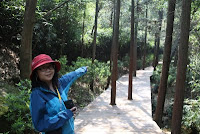
Lao Ban Zhang is an area around three small villages on a southwesterly line. It is composed of perhaps twenty to thirty mountains that have become famous for their tea. This year the prices for tea in this area hit a new high after an army convoy rolled in and bought out the entire spring harvest one week ago. Now the later, lower grade tea has been priced higher than even at its peak in 2007, before the collapse of 2008. While we do not make large purchases of tea, we get a few samples, and even trade a woman for some of her LaoBanZhang, which she picks wild.
 The tea from this sandy sometimes orange/ochre soil has a natural smokey complex not imparted by the cooking. Many refined tea drinking of the north will recoil at the strong green tastes in this Puer, and indeed many of the northen Chinese puer enthusiasts will say a puer is not a puer until it has sat for ten years. The thicker, heaver leaves, and larger tree and root systems of the Yunnan old tea trees mean there is much to naturally age inside the Yunnan tea leaf. Menghai, situated as it is deep down with Laos to the South and Myanmar to the West, has an ecology that is among the most pristine in southeast asia. This microbiology also creates chemical reactions which slowly sweeten and deepen the taste of the tea. Of course when one must wait ten years for a tea to ripen, one must also buy the tea ten years before, when it is a raw puer.
The tea from this sandy sometimes orange/ochre soil has a natural smokey complex not imparted by the cooking. Many refined tea drinking of the north will recoil at the strong green tastes in this Puer, and indeed many of the northen Chinese puer enthusiasts will say a puer is not a puer until it has sat for ten years. The thicker, heaver leaves, and larger tree and root systems of the Yunnan old tea trees mean there is much to naturally age inside the Yunnan tea leaf. Menghai, situated as it is deep down with Laos to the South and Myanmar to the West, has an ecology that is among the most pristine in southeast asia. This microbiology also creates chemical reactions which slowly sweeten and deepen the taste of the tea. Of course when one must wait ten years for a tea to ripen, one must also buy the tea ten years before, when it is a raw puer.So what are the tastes we look for in the raw puer? What flavors now are necessary for a tea after ten years to be not thin but full, not bitter but sweet, not old but ripe?












